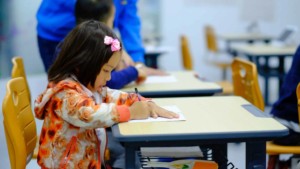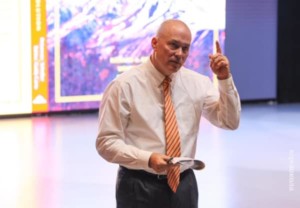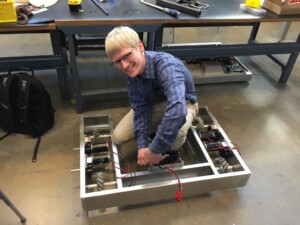Fail Forward: I Fail, So That Students Can Succeed

When you fail, fail forward. Over the course of the next few months, we are going to take a look at failure and its undeniable ability (and necessity) as an ingredient to fuel success. With transparency, I will share, celebrate and highlight both glorious failures of my own and those of leaders throughout our exciting world of innovative learning that have been experience on the growth journey to success. This series is designed to solicit vulnerable learning and, in a perfect world, spark a #FailForward revolution that will undoubtedly promote meaningful change for the learners that we respectively serve.
 Growing up, I was a huge basketball fan. And while my allegiance will always lie with the Seattle Supersonics (#BringBackOurSonics), I had a deep appreciation for the Chicago Bulls of the 1990’s. The accomplishments of Michael Jordan and company were, on many levels, a classroom for lessons that went well beyond basketball, and the chemistry displayed provided an opportunity for back-to-back championships that solidified the rights to a dynasty that is permanently etched into NBA history. In my first classroom, I purchased an incredible poster that captured the drive behind my becoming a teacher and coach (see the image to the left). It was not a “championship” poster, but an illustration of arguably the greatest basketball player of all time being quoted on the power of failure as his personal vehicle to success.
Growing up, I was a huge basketball fan. And while my allegiance will always lie with the Seattle Supersonics (#BringBackOurSonics), I had a deep appreciation for the Chicago Bulls of the 1990’s. The accomplishments of Michael Jordan and company were, on many levels, a classroom for lessons that went well beyond basketball, and the chemistry displayed provided an opportunity for back-to-back championships that solidified the rights to a dynasty that is permanently etched into NBA history. In my first classroom, I purchased an incredible poster that captured the drive behind my becoming a teacher and coach (see the image to the left). It was not a “championship” poster, but an illustration of arguably the greatest basketball player of all time being quoted on the power of failure as his personal vehicle to success.
With access to social media outlets as vehicles for entertainment and learning, I was reminded of my passion for this concept with Gatorade’s newest campaign, The Secret to Victory, in which they highlight prominent athletes’ journeys through personal testimony of failures along the road to success. This goosebump-inducing series of commercials affirms failure (defeat) as a part of success and also solidifies the reality that failure is not an end, but access to a new beginning.
With that, let’s dive in. I have been fortunate to be a part of designing and delivering some extremely innovative learning opportunities for students, and have been equally fortunate to reflect on the failures of these experiences that I experienced in tandem with successes. The first highlight was connected to my involvement as part of a staff that designed and implemented an innovative small schools model for approximately 2,000 students at an urban high school in Washington State. It was well designed, vetted with the community and involved an extensive amount of professional development for staff that was aligned to all aspects of the instructional model. Additionally, it was opened with a brand new building designed to support the model.
The year opened and were on our way. As a staff, we would navigate stumbling blocks associated with doing things “different” but quickly developed a culture that drove change through increased prominence of student voice. Fast forward to the conclusion of year one, and we were left with a staff retention rate of approximately 50%. Loosely translated, half of the staff left for different positions at the conclusion of the first year. The summer of preparing for the next school year was interesting; I had just concluded my fourth year of teaching, and was contemplating aspirations to one day pursue school leadership opportunities, in which I would get to experience the leadership and human resource aspects of the job.
My mindset was, as (almost) always, open to learning. In my experiences, any school that loses that amount of staff is typically labeled as a failure, and in this scenario, the current situation temporarily clouded the successes and accomplishments of the year. There was a dull gloom amongst the staff and understandable concern from the district, students and parents.
Leadership Lesson: It would have been easy, and in many ways expected, that school leadership would invest a great deal of time decoding and identifying the reasons that staff left, but instead it was decided that the focus would be on staff that were committed to the continued development and implementation of the model. Resource allocations were channeled into the discovery of why staff remained with the model as a means of uncovering how we could improve our hiring process to better align with student and community success. I remember sitting with my Academy Principal and having a reflective discussion around the inaugural year and as part of the leadership team, contributing to a plan that would build our staff for the following year. The key elements of this streamlined presentation of failure that ended up supporting our success taught me three key lessons about failure.
 1) Failure is defined by you, for you.
1) Failure is defined by you, for you.
As we stumble and experience set backs in a variety of ventures, we are always presented with choices. We have the luxury of deciding when we stop and we control the definition of failure. In any situation, it is important to look at failure as a series of “pit stops” on the way to the checkered flag of success.
2) Failure is not a conclusion, but rather a new beginning.
In the pursuit of anything, each failure will provide an opportunity to quit or halt the pursuit of success. If your mindset is one of commitment to growth, I recommend using each failure as a building block for a new start, not an ending. One Stone, in Boise, Idaho, is so transparent as a community that they have affirmed their belief in design thinking and the positive role that failure plays, and they have actual signage within the building to remind students and staff of just that.

3) Failure is a necessary part of the equation for success.
Throughout history, we can look at countless examples of persistence towards success that are riddled with failure. One of my favorites revolves around Edison’s creation of the lightbulb, a situation in which it is estimated that thousands of attempts were made prior to success. Insights from these failures added to not only the ultimate creation of the light bulb, but countless innovations connected to the knowledge gained.
Just this week, I was cc’d on an email composed by a former staff member and current teacher in the Tacoma School District, who celebrated and applauded an event within her district that had just concluded its inaugural rollout. It was a summer professional development opportunity designed for teachers, by teachers, in partnership with the district. She articulated her excitement around the learning gained through a lens of making mistakes to better serve students:
“…But I realized one of the things that I appreciated the most was the fact that everything wasn’t perfect. The district people wanted to try something new and a little bit different, and the organizers had the guts to say and show us, “We are going to try this, there are going to be mistakes, we’re going to learn from them, and we’re going to do the best we can for our teachers.” What an amazing message to communicate to teachers as we start out the new year.
Last year I took a new assignment in my building, and it was a little scary. But my principal supported me and encouraged me to try new things and not be afraid to make mistakes. I made lots of mistakes, and my kids did too. We supported one another, and we all learned a lot–me more than them, I’m sure.”
At Getting Smart, we are driven by working with partners who have the courage and vulnerability required to fail in order for students to succeed. If you would like to join the #failforward revolution, are looking for a deeper learning growth partner, or have a story that you would like to share that celebrates failing forward, please contact [email protected].
For more, see:
- Life Prep Should Include Problem-Based Learning, Failure & Leadership
- Getting Smart Podcast | 21 Insights: Adventures in Learning to Lead
- How Gaming Can Encourage Social and Emotional Learning
Stay in-the-know with all things EdTech and innovations in learning by signing up to receive the weekly Smart Update.






SueH
Hi Adam,
I'd like permission to use your 'Fail Forward' sketchnote image in a slide deck learning activity on this topic to be shared with teachers and their students. This will be shared freely by me during unpaid workshops. I will credit you as the artist, link to this webpage, and add a mote of thanks for your generosity.
-SueH
retired Canadian teacher
Replies
Mason Pashia
That would be just fine. Thanks, Sue!